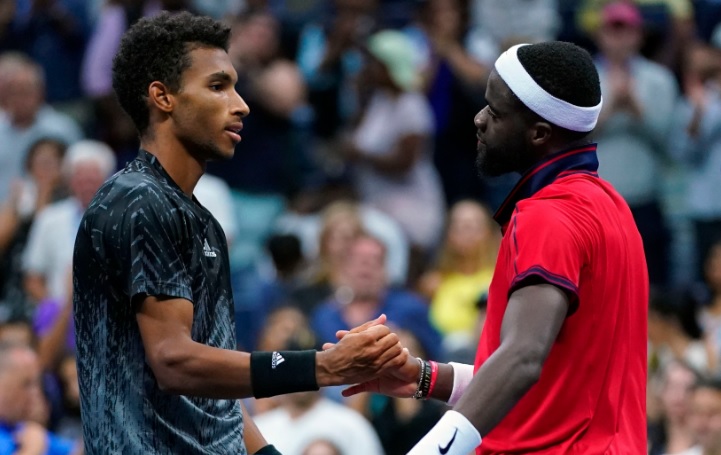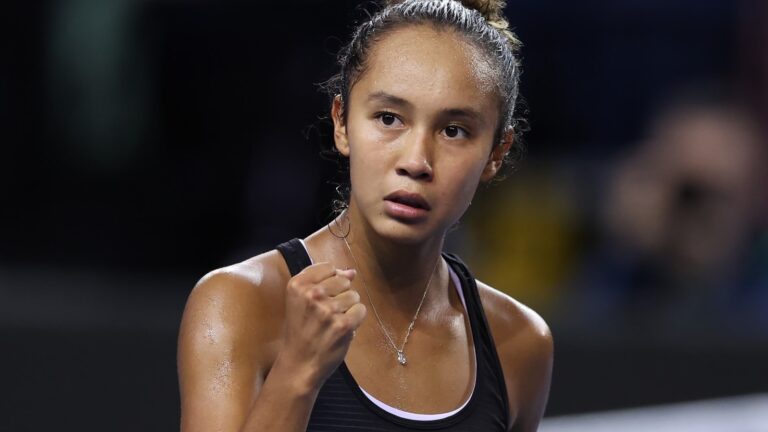
Photo : ABN AMRO World Tennis Tournament
He’s finally done it.
The fantastically promising Félix Auger-Aliassime won an ATP title.
It was one of the longest waits in history in terms of finals without a win. Only Pat Dupre and Cédric Pioline (0/9) fared worse.
But that’s irrelevant now. By ending his seemingly interminable drought, the 21-year-old opened the door to so much more success in the near future.
And that future is BRIGHT.
By annihilating his nemesis at the indoor tournament in Rotterdam, Auger-Aliassime completed his eternal quest and stopped a losing streak against Tsitsipas, who had won their last five matches in the past three years.
The victory even earned FAA a spot on the homepage of the ATP website.

Did Tsitsipas play great tennis? Not really.
But the match was all Félix.
There’s a difference between missing routine shots and being forced to make errors by an opponent who’s playing with perfect rhythm, returning virtually all your first serves and serving like a boss.
And it wasn’t just a great day on serve. It was a great week and it’s been a great year on serve for the Canadian, who’s racking up more aces than ever, keeping his double faults low and getting first serves in like the Top 10 player he is.
And his returns? En route to the Dutch final, two third of Tsitsipas’ serves never came back, but Félix handled 50% of them.
Last weekend, things were really working for the eventual champion. Even his most desperate shots hit the line, much to the dismay of Greek titan, who became more and more slumped over as the match progressed.
For Auger-Aliassime, the ultimate showdown was the quickest of the five battles he fought in Rotterdam. Despite a rocky start against Egor Gerasimov of Belarus, he defeated Sir Andy Murray, poked holes in Cameron Norrie’s defensive wall and dismantled the very powerful Andrey Rublev.
After everything was said and done, even the stoic Frédéric Fontang was grinning ear to ear. That should give you some idea of how satisfied and relieved everyone in the player’s box was.
At 21, Félix is still young, but it did take him nine finals to win the first set (16 lost) and an ATP trophy—a run so long it felt more and more paralyzing with every new chance.
Tennis TV released this short but touching video on all Auger-Aliassime’s career milestones in exactly four years. Don’t forget that it was at Rotterdam Ahoy that his ATP adventure began on February 13, 2018, when he was just 18.
The title consolidates his No.9 ranking and puts him 600 points ahead of Jannik Sinner at No.10 and about 50 points behind No.8 Casper Ruud, who won the tournament in Buenos Aires over hometown hero Diego Schwartzman.
Now, time for an old cliché that’s still very fitting: he’s just getting started!
The pride of Canada will have plenty more opportunities to celebrate, no matter how important the tournament and where in the world it’s held. In the meantime, this post from a fan account sums things up perfectly.
Black History Month

Even before he won his first career title, Félix Auger-Aliassime was part of the new generation of Black athletes who are following in the giant footsteps of pioneering tennis greats like Althea Gibson and Arthur Ashe.
Of course, between Félix, Coco Gauff, Frances Tiafoe and the aforementioned legends, there are Venus and Serena Williams, Sloane Stephens and Naomi Osaka.
I would be remiss if I didn’t mention that Félix’s breakthrough after a frustrating dry spell came right in the middle of February, Black History Month.
Since 1976, February has been dedicated to celebrating the presence, achievements and contributions of members of the Black communities, including professional athletes.
The annual commemoration of the history of the African diaspora was introduced over 45 years ago by US President Gerald Ford. Other countries followed suit, including the UK in 1987, Canada in 1995 and, more recently, Ireland, France and seven African nations.
Several decades ago, sports served as a lever to overcome so many racial barriers. Jesse Owens’ four gold medals in track and field at the 1936 Olympic Games in Berlin and Jackie Robinson’s fight to become the first African American to play in the MLB are shining examples. Today, North American team sports leagues turn a spotlight on the contributions of Black athletes to the social fabric of their communities.
Black Canadians are also making their mark, and Tennis Canada celebrated Black History Month with this reflection on how Félix Auger-Aliassime is inspiring the next generation on and off the courts.
In addition to Félix, a number of Black tennis players have changed the game. Here is a list of trailblazers according to their importance and impact on the game.
1 – Arthur Ashe
2 – Althea Gibson
3 – Serena Williams and Venus Williams
4 – Naomi Osaka
5 – Sloane Stephens
6 – Yannick Noah
7 – Jo-Wilfried Tsonga
8 – Gaël Monfils
9 – Lori McNeil
10 – Madison Keys
11 – Zina Garrison
12 – Chanda Rubin
13 – MaliVai Washington
14 – Coco Gauff
15 – James Blake
16 – Frances Tiafoe
17 – Katrina Adams
18 – Asia Muhammad
19 – Dustin Brown
20 – Ronald Agénor
21 – George Stewart
As far as the name at no.21, you may not be familiar with George Stewart. I wasn’t. But while reading up on Black History Month, I found this Tweet that prompted me to add him to the list, which, of course, is only partial.
To learn more, type #BlackHistoryMonth in the Twitter search bar or your favourite search engine. @TennisCanada created a dedicated series, and so did a number of other tennis media outlets, including the Tennis Hall of Fame with Breaking Boundaries.

Beyond the sport, the list of Black women and men who’ve inspired the world is impressive, and you probably already know a lot of them.
Let’s wrap things up with this nearly four-minute video by Sporting News entitled Black History Month: Celebrating Black Pioneers in Sport.
Inspiring.
Land of the giant servers
This is a tale of two giant servers, countrymen and frequent opponents these days.

On Saturday, at the ATP 250 Dallas Open, John Isner and Reilly Opelka went head-to-head in a semifinal that played out just like all their previous battles: in a bazooka gunfight.
Not only was there a record number of aces in a two-set match, but the most recent tiebreak in their long list of deciding sets also smashed a record. It took 46 points to win the third set: 24–22 for Opelka and a new record for the longest tiebreak in terms of points played since the ATP was created in 1990.
Since 2016, Isner (2.08 m) and Opelka (2.11 m) have fought it out five times. Isner won their first and most one-sided battle in the semis in Atlanta (6-7 (5), 6-4, 6-2), breaking Opelka three times. In their next four duels (Melbourne, New York and Atlanta in 2019 and Dallas on February 12), which Opelka dominated, there were no break points (NONE!) and a total of 12 sets that all (EVERY SINGLE ONE!) went to a tiebreak.
To answer your question, there were 329 aces in their 5 matches.
That’s 66 per match.
And that’s 33 per player, per match.
Servebots, you say?
Servbots (not servebots, note the spelling) or Kobun in Japanese, have been around a lot longer than Raonic, Karlovic, Isner or Opelka. They’re actually small all-purpose robot characters created in 1997 as part of the Mega Man Legends series. The tiny henchmen each have distinct personalities and are tasked with building, operating and fixing machines. More on them here.

With that in mind, there doesn’t seem to be a link between the animated Servbots and the servebots in tennis, including the two friendly American giants. In tennis, servebot even has a somewhat negative connotation.
Yes, the rallies are shorter because the players on the receiving end have a tough time returning. Still, we’ve learned to appreciate the quality of the tennis played by Isner, Opelka and others, like Cilic, Bublik, Medvedev and, most recently, Maxime Cressy of the US.
How do Isner and Opelka feel about being dubbed servebots? They laugh it off. “I mean, quite frankly, Isner and I joke about the term servebot. Of course, I leave it to the tennis media to come up with that word or term or whatever. We just joke around with it now,” said Opelka last summer in Toronto after sending Roberto Bautista Agut home and signing Servebot on the camera operator’s lens after the win.
He also added that it takes more than big serves to get to two back-to-back Masters 1000 semifinals in Rome and Toronto: “I mean, anyone who knows anything about tennis knows that the ball comes back no matter how good your serve is. Maybe one or two matches a year, where Isner and I pitch a perfect game, we don’t have to hit too many balls. Isner’s more than serve, as am I. You don’t get to be No.20 in the world with just one shot. It’s just silly. It’s ridiculous.”
That said, be prepared. It’s not science fiction anymore.
Will bots dominate planet tennis?
Email: privard@tenniscanada.com
Twitter: @paul6rivard
Follow all our Canadians in action here.




